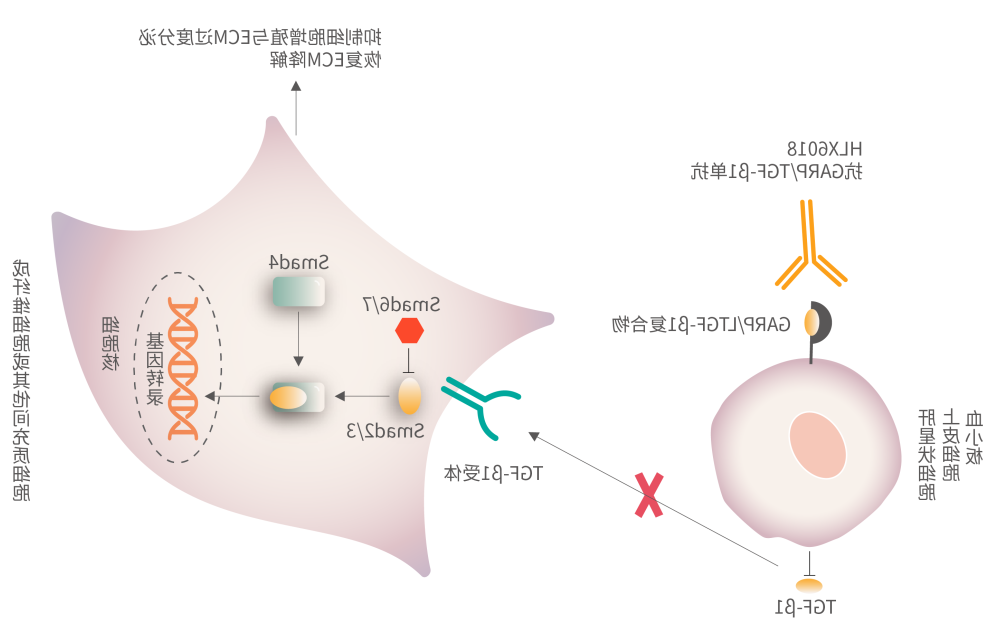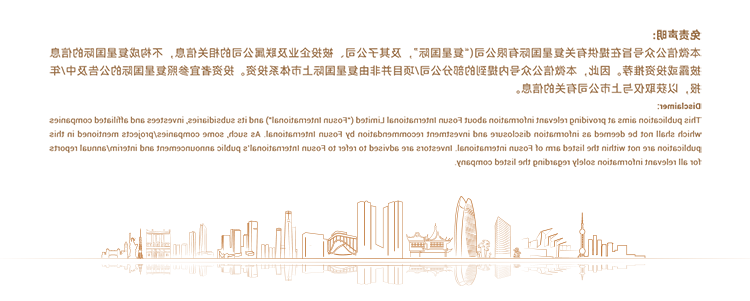复宏汉霖创新产品抗GARP/TGF-β1单抗获国家药监局临床试验批准

相关内容起源:复宏汉霖

纤维化是一种以组织瘢痕为特征的病理过程,多因感染、自身免疫反应、辐射、机械损伤等因素引发细胞外基质(extracellular matrix, ECM)过度沉积,导致正常组织变成永久性组织瘢痕,常见的纤维化相关疾病包括IPF、非酒精性脂肪性肝炎/代谢功能障碍相关脂肪性肝炎、肝硬化、慢性肾脏疾病、心肌梗死等[1]。其中, IPF是一类发病机制尚不明确的慢性进行性间质性肺病,于2018年被列入国家《第一批罕见病名录》-1。目前表格,全球性范围内内已建约200万IPF的人,且发病原因率和意外生存率仍在不间断的提升-1。该常见消化道疾病发多于中中年人女性,患有因肺的重大突破性仟维化引起的肺职能无法无法挽救地缺失,后面引起自杀。且IPF环境率差,患有临床诊断后中位环境期仅为3-5年,多年环境率不足之处30%,有的超过多类癌肿常见消化道疾病[2]。现下,IPF的进行调理会选择如此限制,且仅存肿瘤药材仅能抑制肺性能下调,安全性高、管用的抗肺食物纤维化进行调理肿瘤药材会出现太大的未够满足的诊疗供给。
转化生长因子-β(transforming growth factor-β, TGF-β)是一种多效细胞因子,在所有类型的组织纤维化发生和发展过程中都发挥着关键作用。研究表明,TGF-β1通过激活Smad依赖性或非依赖性信号通路,介导肌纤维母细胞(Myofibroblast)的激活、ECM的过量产生和ECM降解的抑制等,从而引起肺、肝、肾和心脏等器官的纤维化-2。糖蛋白A重复优势蛋白(glycoprotein-A repetitions predominant,GARP)是潜在转化生长因子β1(latent transforming growth factor-β1, LTGF-β1)的对接受体,表达于血小板及多类细胞表面。GARP通过与LTGF-β1结合形成GARP-LTGF-β1复合物,进而促进成熟TGF-β1的分泌和活化,成为TGF-β1成熟释放的重要途径之一-1。

HLX6018要能特女性朋友运用内部及血人体细胞漆层的GARP/TGF-β1组合物,然而阻挡GARP介导的TGF-β1比较成熟缓解压力,因而压制TGF-β1介导的成棉合成人造仟维素棉内部的激发、分裂繁殖和ECM的分泌物,到达调理棉合成人造仟维素棉化想关传染性疫情的依据。临床学习前学习中,HLX6018现在已经塑造出显著性的抗肺棉合成人造仟维素棉化及肾棉合成人造仟维素棉化为用,且具备优异的安全的性。除特发性肺棉合成人造仟维素棉化外,事件,复宏汉霖也将接着探究HLX6018在肾棉合成人造仟维素棉化、肝棉合成人造仟维素棉化等更大棉合成人造仟维素棉化传染性疫情中的有效时间。
焦聚未需要满足的监床消费需求,复宏汉霖将维持大幅度产品开发建设产品开发建设,以良性良性肿瘤为基础,不间断拓展活动非良性良性肿瘤范畴的进行治疗方案设计,会加快开发建设太多防护可行的产品开发建设用药,以可负担过重的高品質产品开发建设药造福亚洲地区糖尿病患者。
关于复宏汉霖
复宏汉霖前瞻性布局了一个多元化、高质量的产品管线,涵盖20多种创新单克隆抗体,并全面推进基于自有抗PD-1单抗H药汉斯状®的肿瘤免疫联合疗法。继国内首个生物类似药汉利康®(利妥昔单抗)、中国首个自主研发的中欧双批单抗药物汉曲优®(曲妥珠单抗,欧洲商品名:Zercepac®,澳大利亚商品名:Tuzucip®和Trastucip®)、汉达远®(阿达木单抗)和汉贝泰®(贝伐珠单抗)相继获批上市,创新产品汉斯状®(斯鲁利单抗)已获批用于治疗微卫星高度不稳定(MSI-H)实体瘤、鳞状非小细胞肺癌、广泛期小细胞肺癌和食管鳞状细胞癌,并成为全球首个获批一线治疗小细胞肺癌的抗PD-1单抗。公司亦同步就16个产品在全球范围内开展30多项临床试验,对外授权全面覆盖欧美主流生物药市场和众多新兴市场。
The IND Application of Henlius’ Novel Anti-GARP/TGF-β1 mAb HLX6018 Approved by NMPA
Shanghai, China, Mar 12th, 2024 - Shanghai Henlius Biotech, Inc. (2696.HK) announced the investigational new drug (IND) application for clinical trial of HLX6018,a novel anti-GARP/TGF-β1 monoclonal antibody (mAb) independently developed by the company, was approved by the National Medical Products Administration (NMPA) for the treatment of idiopathic pulmonary fibrosis (IPF). HLX6018 is the first innovative product of Henlius in the treatment field of chronic inflammatory diseases. Currently, no mAb targeting GARP/TGF-β1 has been approved for marketing globally.
Fibrosis is a pathological process characterised by persistent tissue scars which attributed to excessive deposition of extracellular matrix (ECM). This condition can be induced by a variety of stimuli such as infections, autoimmune reactions, radiation, and tissue injury. Common fibrosis-related diseases include IPF, non-alcoholic steatohepatitis (NASH)/metabolic dysfunction-associated steatohepatitis (MASH), cirrhosis, chronic kidney disease (CKD), myocardial infarction (MI), etc[1]. Among them, IPF is a chronic, progressive interstitial lung disease with unknown etiology, and was incorporated into the first National List of Rare Diseases in 2018-1. It is estimated that there are almost 2 million IPF patients in the globe, with its incidence and mortality still rising-1. IPF occurs mostly in elderly men, and the patients suffer from irreversible loss of lung function due to progressive lung fibrosis, which ultimately leads to death. Furthermore, the overall prognosis of IPF is poor, with the median survival of patients is only 3-5 years after diagnosis, and five-year survival rate less than 30%, which is even lower than multiple types of tumour[2]. Currently, treatment options for IPF are very limited, and have just shown their potential for delaying the decline of lung function. There is a large unmet clinical need in the treatment of IPF.
Transforming growth factor-β (TGF-β) is a pleiotropic cytokine and plays critical roles in the initiation and progression of all types of tissue fibrosis. Recent evidence shows that TGF-β1 can induce fibrosis via activation of both Smad-based and non-Smad-based signaling pathways, which result in activation of myofibroblasts, excessive production of ECM and inhibition of ECM degradation-2. Glycoprotein-A repetitions predominant (GARP) is highly expressed on the surface of platelets and other cell types and acts as a docking receptor by binding to latent transforming growth factor-β1 (LTGF-β1). Subsequently, mature TGF-β1 was further activated and released from the GARP/LTGF-β1 complex-1.
About Henlius
Henlius (2696.HK) is a global biopharmaceutical company with the vision to offer high-quality, affordable, and innovative biologic medicines for patients worldwide with a focus on oncology, autoimmune diseases, and ophthalmic diseases. Up to date, 5 products have been launched in China, 2 has been approved for marketing in overseas markets, 19 indications are approved worldwide, and 7 marketing applications have been accepted for review in China, the U.S., and the EU, respectively. Since its inception in 2010, Henlius has built an integrated biopharmaceutical platform with core capabilities of high-efficiency and innovation embedded throughout the whole product life cycle including R&D, manufacturing and commercialization. It has established global innovation center and Shanghai-based manufacturing facilities in line with global Good Manufacturing Practice (GMP), including Xuhui Facility and Songjiang First Plant, both certificated by China and the EU GMP.
Henlius has pro-actively built a diversified and high-quality product pipeline covering over 20 innovative monoclonal antibodies (mAbs) and has continued to explore immuno-oncology combination therapies with proprietary HANSIZHUANG (anti-PD-1 mAb) as backbone. Apart from the launched products HANLIKANG (rituximab), the first China-developed biosimilar, HANQUYOU (trastuzumab for injection, trade name in Europe: Zercepac®; trade names in Australia: Tuzucip® and Trastucip®), the first China-developed mAb biosimilar approved both in China and Europe, HANDAYUAN (adalimumab) and HANBEITAI (bevacizumab), the innovative product HANSIZHUANG has been approved by the NMPA for the treatment of MSI-H solid tumors, squamous non-small cell lung cancer (sqNSCLC) and extensive-stage small cell lung cancer (ES-SCLC), and esophageal squamous cell carcinoma (ESCC), making it the world's first anti-PD-1 mAb for the first-line treatment of SCLC. What's more, Henlius has conducted over 30 clinical studies for 16 products, expanding its presence in major markets as well as emerging markets.
【选取论文】
[1] Wynn T A . Cellular and molecular mechanisms of fibrosis.Journal of Pathology, 2010, 214(2):199-210.
[2] Wu W, et al. BMJ Open 2021; Effcacy and safety of pirfenidone in the treatment of idiopathic pulmonary fbrosis patients: a systematic review and meta-analysis of randomized controlled trials. 11:e050004.
[3] 的国家食品卫生健康的促进会会等《第1批罕有病明单》
[4] Maher, T.M., Bendstrup, E., Dron, L. et al. Global incidence and prevalence of idiopathic pulmonary fibrosis. Respir Res 22, 197 (2021).
[5] 《国特发性肺纤维棉化人职业提升未来发展趋势学习与的投资非常好预估数据》
[6] Meng XM, Nikolic-Paterson DJ, Lan HY. TGF-β: the master regulator of fibrosis. Nat Rev Nephrol. 2016;12(6):325-38.
[7] Ghafoory S, Varshney R, Robison T, et al. Platelet TGF-β1 deficiency decreases liver fibrosis in a mouse model of liver injury. Blood Adv. 2018 Mar 13;2(5):470-480.
[8] Inui N, Sakai S, Kitagawa M. Molecular Pathogenesis of Pulmonary Fibrosis, with Focus on Pathways Related to TGF-β and the Ubiquitin-Proteasome Pathway. Int J Mol Sci. 2021 Jun 5;22(11):6107.
[9] Tran DQ, Andersson J, etc. GARP(LRRC32)is essential for the surface expression of latent TGF-beta on platelets and activated FOXP3+ regulatory T cells. Proceedings of the National Academy of Sciences of the United States of America. 2009; 106(32) :13445-13450.
[10] Metelli A, Wu BX, Riesenberg B, et al. Thrombin contributes to cancer immune evasion via proteolysis of platelet-bound GARP to activate LTGF-β. Sci Transl Med. 2020;12(525): eaay4860.









